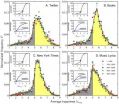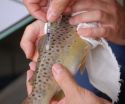(Press-News.org) New Orleans, LA – A study led by Russell R. Russo, MD, a third-year Orthopaedic Surgery resident at LSU Health Sciences Center New Orleans School of Medicine, has identified a new source of life-threatening necrotizing fasciitis – "bath salts." The study, describing the first known case of necrotizing fasciitis from an intramuscular injection of the street drug known as "bath salts," is published in the January 2012 issue of Orthopedics, now available online.
Necrotizing fasciitis is an orthopedic emergency. The ability to quickly and accurately diagnose this rapidly spreading disease can save a patient's life and limb. However, the diagnosis is complex because necrotizing fasciitis usually manifests as a less severe cellulitis or abscess while the majority of the damage rages beneath the surface of the skin. Deep muscular necrosis is often masked by a normal-looking overlying tissue bed. The potential causes and vectors, or carriers, continually change.
"As 'bath salts' gain popularity, medical centers of all disciplines must be prepared to identify not only the signs of intoxication, but the potential side effects including deadly necrotizing fasciitis," notes Dr. Russo.
Dr. Russo and his colleagues treated a 34-year-old woman who presented with forearm pain and redness that began after she attended a party. She did not report other symptoms, but there was also a small red puncture wound on her arm. Treatment for cellulitis with broad-spectrum IV antibiotics dramatically reduced the symptoms, but lingering pain at the injection site led to an ultrasound. She then admitted that she had injected "bath salts" two days before she developed symptoms. When the patient was reexamined, she had rapidly progressing redness, skin sloughing, and drainage. Necrotizing fasciitis was suspected and she immediately underwent emergent surgical debridement and exploration, and more antibiotics were added. The infection moved so fast that pink, healthy tissue was literally dying before the surgeons' eyes. They had to keep removing tissue until they reached clear margins of healthy tissue to stop the progression of disease. By the time they were finished, the patient's arm, shoulder, and collarbone had to be amputated, and a radical mastectomy performed. The patient survived and subsequently underwent skin grafting and rehabilitation. Analysis revealed bacterial isolates including alphahemolytic Streptococcus, Streptococcus viridans, Peptostreptococcus micros, Gemella morbillorum, and Actinomyces odontolyticus.
The researchers note these infections are usually associated with crush traumas and farm injuries, but now physicians must also be prepared and vigilant when presented with a cellulitic patient who has a history of needle use. Even patients with their own clean needles are not immune, as evident in a report of an asthmatic patient who developed necrotizing fasciitis from an injection of subcutaneous epinephrine.
"Despite the drug's legal status, it must be treated as illicit, and one must be suspicious when examining a patient with this clinical history because the diagnosis of flesh-eating bacteria can masquerade as abscesses and cellulitis," says Dr. Russo.
Necrotizing fasciitis has a rapid time-line to tissue destruction and loss of life. A 1995 study found the survival rate of those diagnosed with necrotizing fasciitis to be as low as 50%. However, wide ranges of death exist depending on a multitude of factors.
Treatment for this virulent disease remains a swift diagnosis with extensive surgical debridement to obtain complete control of the organism and prevent death. However, the authors maintain, the best treatment is prevention with public, street-based education and early detection.
"The recent emerging popularity of this highly obtainable, injectable substance may lead to an increase in cases of necrotizing fasciitis," concludes Dr. Russo, "and surgeons must be ready to diagnose and perform extensive debridements in association with general surgeons in some instances to save limbs, preserve function, and prevent death."
INFORMATION:
The study team included Dr. Noah Marks, Dr. Katy Morris, and Associate Professor Dr. Ronald Rooney, in the LSUHSC New Orleans Department of Orthopaedic Surgery, as well as Drs. Heather King, and Angelle Gelvin, MD in the LSUHSC New Orleans Department of Surgery.
LSU Health Sciences Center New Orleans educates Louisiana's health care professionals. The state's academic health leader, LSUHSC consists of a School of Medicine, the state's only School of Dentistry, Louisiana's only public School of Public Health, the only School of Nursing within an academic health center in Louisiana, and Schools of Allied Health Professions, and Graduate Studies. LSUHSC faculty take care of patients in public and private hospitals and clinics throughout the region. In the vanguard of biosciences research in a number of areas in a worldwide arena, the LSUHSC research enterprise generates jobs and enormous economic impact. LSUHSC faculty have made lifesaving discoveries and continue to work to prevent, advance treatment, or cure disease. To learn more, visit http://www.lsuhsc.edu and http://www.twitter.com/LSUHSCHealth.
END
TORONTO, Ont., Jan. 12, 2012—Researchers at St. Michael's Hospital have published the first detailed figures showing the risk of using the prescription drug Rasilez in combination with certain other blood pressure-lowering medications.
The pharmaceutical company Novartis terminated a large, international clinical trial of the drug last month after finding an increased incidence after 18-24 months of non-fatal strokes, renal complications, high levels of potassium in the blood and low blood pressure.
As a result, Health Canada said on Dec. 22 that it would review the ...
A new study published in the journal Nature Medicine by NYU Cancer Institute researchers, shows how the cancer causing gene Notch, in combination with a mutated Polycomb Repressive Complex 2 (PRC2) protein complex, work together to cause T- cell acute lymphoblastic leukemia (T-ALL).
T-ALL is an aggressive blood cancer, predominately diagnosed in children. It occurs when one lymphoblast, an immature white blood cell, turns malignant, multiplying uncontrollably and spreading rapidly throughout the body. If left untreated, the disease can be fatal in a few weeks. Cancer-causing ...
WEST LAFAYETTE, Ind. - Honeybee populations have been in serious decline for years, and Purdue University scientists may have identified one of the factors that cause bee deaths around agricultural fields.
Analyses of bees found dead in and around hives from several apiaries over two years in Indiana showed the presence of neonicotinoid insecticides, which are commonly used to coat corn and soybean seeds before planting. The research showed that those insecticides were present at high concentrations in waste talc that is exhausted from farm machinery during planting.
The ...
"If it bleeds, it leads," goes the cynical saying with television and newspaper editors. In other words, most news is bad news and the worst news gets the big story on the front page.
So one might expect the New York Times to contain, on average, more negative and unhappy types of words — like "war," " funeral," "cancer," "murder" — than positive, happy ones — like "love," "peace" and "hero."
Or take Twitter. A popular image of what people tweet about may contain a lot of complaints about bad days, worse coffee, busted relationships and lousy sitcoms. Again, it might ...
TAMPA, Fla. (Jan. 12, 2012) – Using two cell surface markers found to be highly expressed in breast cancer lymph node metastases, researchers at Moffitt Cancer Center, working with colleagues at other institutions, have developed targeted, fluorescent molecular imaging probes that can non-invasively detect breast cancer lymph node metastases. The new procedure could spare breast cancer patients invasive and unreliable sentinel lymph node (SLN) biopsies and surgery-associated negative side effects.
Their study was published in a recent issue of Clinical Cancer Research ...
For years, researchers seeking new therapies for traumatic brain injury have been tantalized by the results of animal experiments with stem cells. In numerous studies, stem cell implantation has substantially improved brain function in experimental animals with brain trauma. But just how these improvements occur has remained a mystery.
Now, an important part of this puzzle has been pieced together by researchers at the University of Texas Medical Branch at Galveston. In experiments with both laboratory rats and an apparatus that enabled them to simulate the impact of ...
Researchers at the University of Oviedo (Spain) have come up with a way of tagging gunpowder which allows its illegal use to be detected even after it has been detonated. Based on the addition of isotopes, the technique can also be used to track and differentiate between wild fish and those from a fish farm, such as trout and salmon.
A new method for tagging and identifying objects, substances and living beings has just been presented in this month's issue of the Analytical Chemistry journal. Its creators are scientists at the University of Oviedo who have patented the ...
A new study on African bats provides a vital clue for unravelling the mysteries in Australia's battle with the deadly Hendra virus.
The study focused on an isolated colony of straw-coloured fruit bats on islands off the west coast of central Africa. By capturing the bats and collecting blood samples, scientists discovered these animals have antibodies that can neutralise deadly viruses known in Australia and Asia.
The paper is published today, 12 January, in the journal PLoS ONE, and is a collaboration of the Department of Veterinary Medicine at the University of ...
Polymer nano-films and nano-composites are used in a wide variety of applications from food packaging to sports equipment to automotive and aerospace applications. Thermal analysis is routinely used to analyze materials for these applications, but the growing trend to use nanostructured materials has made bulk techniques insufficient.
In recent years an atomic force microscope-based technique called nanoscale thermal analysis (nanoTA) has been employed to reveal the temperature-dependent properties of materials at the sub-100 nm scale. Typically, nanothermal analysis ...
BOSTON, January 12, 2012: A research collaboration between the Wyss Institute for Biologically Inspired Engineering at Harvard University and Children's Hospital Boston has developed "smart" injectable nanotherapeutics that can be programmed to selectively deliver drugs to the cells of the pancreas. Although this nanotechnology will need significant additional testing and development before being ready for clinical use, it could potentially improve treatment for Type I diabetes by increasing therapeutic efficacy and reducing side effects.
The approach was found to increase ...


